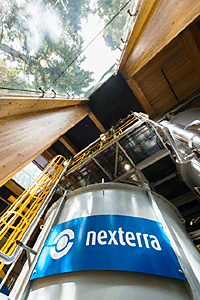Nexterra, UBC, GE Complete First Renewable Biomass CHP System in North America
 Print this article | Send to Colleague Print this article | Send to Colleague
 Nexterra Systems Corp. Vancouver, B.C., Canada, the University of British Columbia, and GE this past week celebrated the successful completion of an energy-from-renewable-waste combined heat and power (CHP) system located at UBC's Vancouver campus. This is North America's first commercial demonstration of a transformative system that combines Nexterra's gasification and syngas conditioning technologies with one of GE's high-efficient Jenbacher internal combustion engines. Nexterra Systems Corp. Vancouver, B.C., Canada, the University of British Columbia, and GE this past week celebrated the successful completion of an energy-from-renewable-waste combined heat and power (CHP) system located at UBC's Vancouver campus. This is North America's first commercial demonstration of a transformative system that combines Nexterra's gasification and syngas conditioning technologies with one of GE's high-efficient Jenbacher internal combustion engines.
GE's Jenbacher gas engine will produce 2 MW of clean, renewable electricity that will offset UBC's existing power consumption, enough to power approximately 1,500 homes. The Nexterra system will also generate 3 MW of thermal energy, enough steam to displace up to 12% of UBC's natural gas consumption. This will reduce UBC's greenhouse gas emissions by up to 5,000 metric tpy, the equivalent of taking more than 1,000 cars off the road.
The successful startup of the project at UBC, officially named the Bioenergy Research and Demonstration Facility (BRDF), represents an important milestone in Nexterra's quest to reliably convert low-value waste feedstocks into higher value renewable fuels and chemicals. The system has completed a comprehensive testing program for reliability, capacity, and emissions, and has successfully connected to the grid.
Using Nexterra's proven gasification technology platform and innovative gas cleanup and thermal cracking solution, the system converts locally-sourced waste wood into a clean, reliable gas that is suitable for use in a high-efficiency, industrial-scale gas engine to produce heat and power. The system will deliver global electrical efficiencies that are 25% higher than traditional methods for producing biomass-based electricity at this scale.
Startup of the system represents the culmination of more than four years of product development work and collaboration with GE's Gas Engines business. Prior to installing the gas engine at UBC, Nexterra successfully completed more than 5,000 hr of trials at its Product Development Center in Kamloops, B.C.
Designed by McFarland Marceau Architects, UBC's CHP bioenergy system is housed in a building that was constructed using cross-laminate timber (CLT), a new solid wood building material that can be used as a low carbon, renewable alternative to steel frame construction. This will be one of the first CLT buildings in North America and will demonstrate its market potential for the forest industry.
Funding support for this project was provided by: the Government of Canada (Natural Resources Canada and Western Economic Diversification Canada); the Province of British Columbia (B.C. Innovative Clean Energy Fund and the Ministry of Forests, Mines, and Lands); Sustainable Development Technologies Canada (SDTC); the BC Bioenergy Network; and FP Innovations.
|
|

